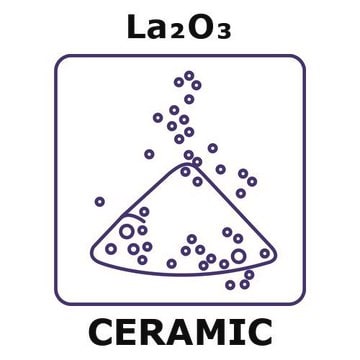L4000
Lanthanum(III) oxide
≥99.9%
Synonym(s):
Lanthana, Lanthanum sesquioxide, Lanthanum trioxide
About This Item
Recommended Products
Assay
≥99.9%
form
powder
reaction suitability
reagent type: catalyst
core: lanthanum
density
6.51 g/mL at 25 °C (lit.)
application(s)
battery manufacturing
SMILES string
O=[La]O[La]=O
InChI
1S/2La.3O
InChI key
KTUFCUMIWABKDW-UHFFFAOYSA-N
Looking for similar products? Visit Product Comparison Guide
General description
Application
It can be used to prepare thermal-barrier coatings with a high thermal expansion coefficient and low thermal conductivity.
It can also be used as a recyclable catalytic system for the synthesis of diphenyl sulfides and selenides.
Features and Benefits
- High refractive index
- Thermal stability
- Hardness
- High dielectric constant
Storage Class Code
13 - Non Combustible Solids
WGK
WGK 3
Flash Point(F)
Not applicable
Flash Point(C)
Not applicable
Personal Protective Equipment
Certificates of Analysis (COA)
Search for Certificates of Analysis (COA) by entering the products Lot/Batch Number. Lot and Batch Numbers can be found on a product’s label following the words ‘Lot’ or ‘Batch’.
Already Own This Product?
Find documentation for the products that you have recently purchased in the Document Library.
Customers Also Viewed
Our team of scientists has experience in all areas of research including Life Science, Material Science, Chemical Synthesis, Chromatography, Analytical and many others.
Contact Technical Service












